A deeper look at how Ethereum works
From the findings of the University of Tokyo Blockchain Innovation Endowed Chair
Table of Contents
- Introduction.
- Basic Concept of Ethereum
- Major Components of Ethereum
- Ethereum Blockchain Structure
- Consensus Mechanisms and Mining Rewards
- Addressing Scalability Issues
- Governance and EIP
- Conclusion.
- Supplemental explanation of terminology
- Development Information
- Related article (Blockchain Public Lecture Series):
Introduction.
Ethereum is a virtual currency with the second largest market capitalization after Bitcoin and a blockchain platform with innovative "smart contract" functionality. This article explains in detail how Ethereum works and its features based on materials from the University of Tokyo's Blockchain Innovation Endowed Chair.
Launched in 2015 by Vitalik Buterin and others, Ethereum has rapidly grown as a development platform for distributed applications (DApps). Its innovative design philosophy and flexibility have enabled blockchain applications in fields as diverse as finance, the arts, and gaming.

Basic Concept of Ethereum
Ethereum is a generalized version of the Bitcoin protocol.
- Generalization of processingSimple remittance ŌåÆ Program execution
- While Bitcoin deals only with simple value transfers, Ethereum is capable of executing programs (smart contracts) that contain complex logic.
- Generalization of management targetsBitcoin transfer records ŌåÆ Account state transition records
- While Bitcoin uses the UTXO (unused transaction output) model, Ethereum uses an account-based model. This allows for more complex state management.

With these generalizations, Ethereum aims to function as a "world computer". That is, it functions as a single giant computer shared around the world, providing a platform on which anyone can freely run programs.
Major Components of Ethereum
Account Type
- EOA (Externally Owned Account): A account that is owned by the company.
- Externally owned accounts managed by humans
- Has a private key and can initiate transactions
- Balance (ETH) can be held
- CA (Contract Account): A contract account that is used to pay for the services of a contractor.
- Smart Contract Accounts
- Maintains program code and status
- No private key, only activated by a transaction from the EOA
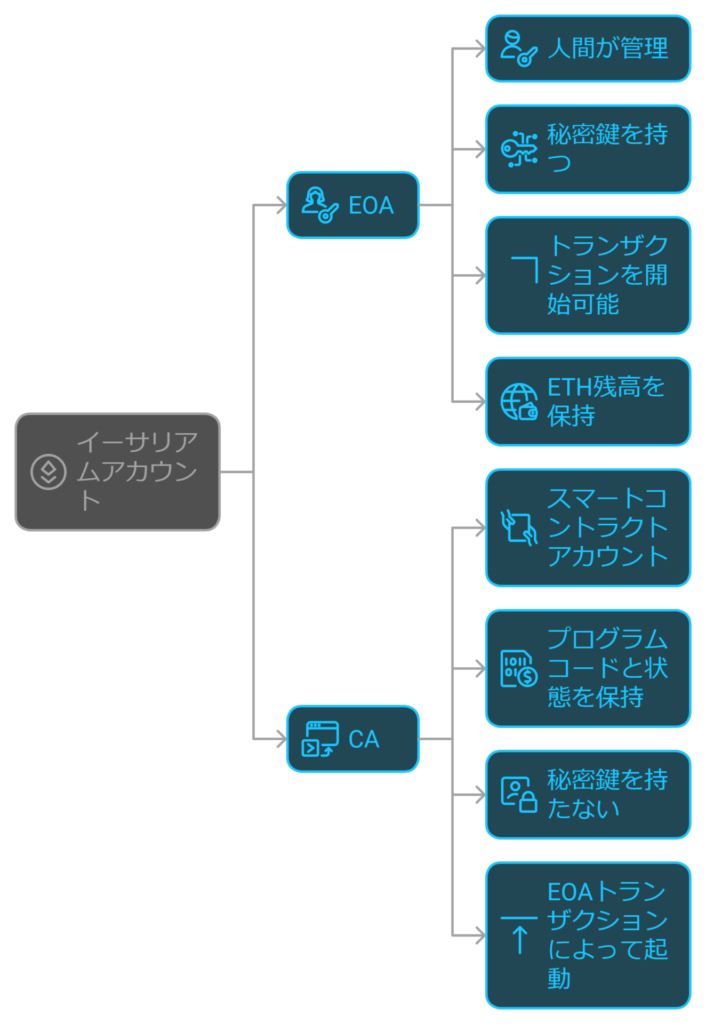
Transaction type
- Message Call: (1)
- Normal remittance or existing contract execution
- Used for EOA to EOA, EOA to CA, CA to CA (internal transaction) communication
- Contract Creation
- Creating a new smart contract
- Generate a new CA and place code at that address

EVM (Ethereum Virtual Machine)
- Virtual machine to execute smart contracts
- Converts code written in high-level languages such as Solidity into bytecode and executes it
- Stack-based virtual machines ensure deterministic execution

Gas
- Unit of measure for the amount of computation required to execute a transaction
- Used to prevent spam attacks and properly allocate computing resources
- gasLimit: Maximum amount of gas that can be used for a transaction
- baseFeePerGas: Base fee that varies depending on network congestion
- priorityFeePerGas: additional rewards (chips) for miners

Ethereum Blockchain Structure
Ethereum blocks contain more information than bitcoin:
- State Root:
- Hash value summarizing the state of all accounts in a Markle Patricia tree
- Enables efficient state verification
- Receipts Root:
- Hash value summarizing all transaction execution results in a Markle Patricia tree
- Used to prove transaction execution
- Uncle Blocks:
- Information on blocks branched from the main chain (max. 2)
- Improve network security and fairness of miners
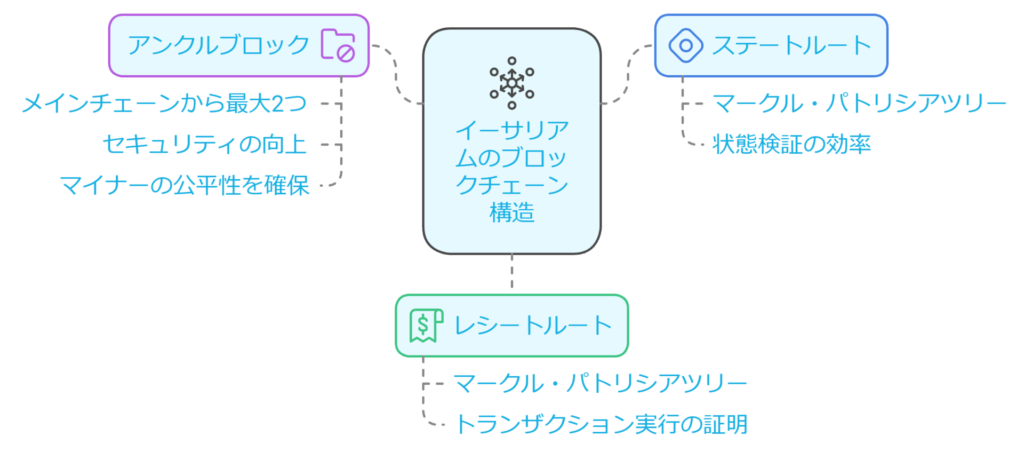
These structures allow Ethereum to efficiently manage more complex state management and execute sophisticated smart contracts.
Consensus Mechanisms and Mining Rewards
- GHOST Protocol:
- The "heaviest chain" is legitimate.
- Improved safety in environments where frequent branching occurs
- Chain weights are calculated taking Uncle Blocks into account
- Mining Rewards:
- Successful block creation: 2 ETH newly issued
- Uncle Block containing: additional reward available (up to 3.1251 TP3T more)
- Reward for Uncle Block creator: 87.5% for 2ETH
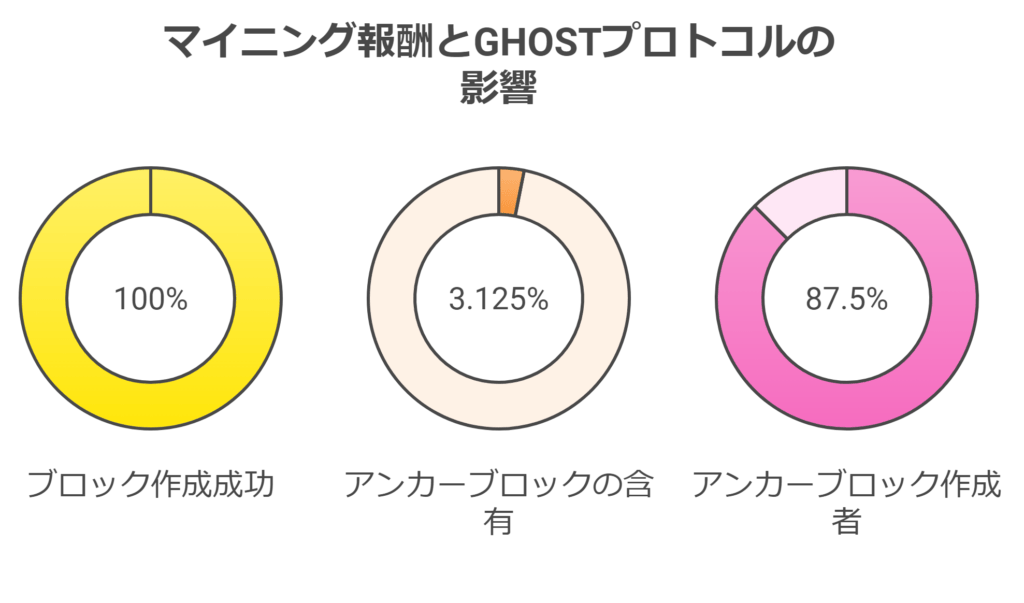
This system promotes decentralization and fairness of miners and enhances the security of the network.
Addressing Scalability Issues
Current status: Ethereum (10-20 TPS) > Bitcoin (5 TPS)
TPS: Transactions Per Second
Remedies:.
- The Merge:
- Transition from PoW (Proof of Work) to PoS (Proof of Stake)
- Significantly improves energy efficiency and lays the foundation for future scaling
- Sharding:
- Network is partitioned into multiple "shards" for parallel processing
- Theoretical potential to increase throughput by hundreds of times
- Layer 2 Solution:
- Zero-knowledge rollups: compress large transaction volumes while protecting privacy
- Optimistic rollups: process transactions outside the main chain and report results later in batches
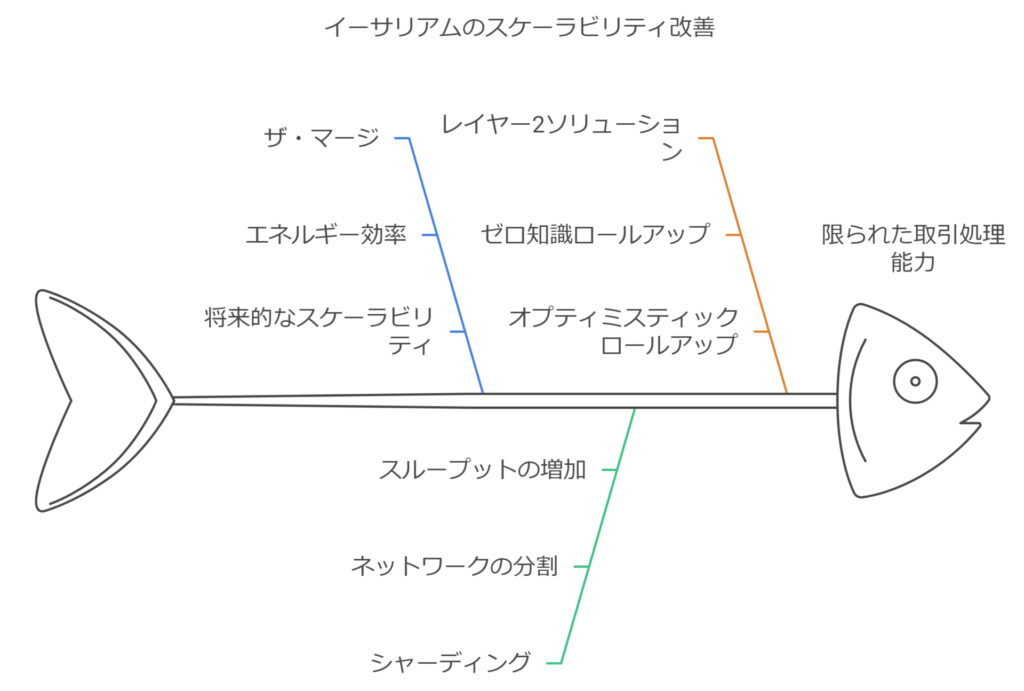
Target: 100,000 TPS
With these improvements, Ethereum aims to make large-scale decentralized applications practical.
Governance and EIP
Propose and discuss specification changes through EIP (Ethereum Improvement Proposal)
Examples of major EIPs:.
- EIP20: Fungible Token Standard
- Define standards for ERC20 tokens to enable compatible token creation
- EIP721: Non-Fungible Token (NFT) Standard
- Establish a standard for NFTs to represent unique assets
- EIP1155: Semi-Fungible Token Standard
- Manage multiple types of tokens (FT and NFT) with one contract
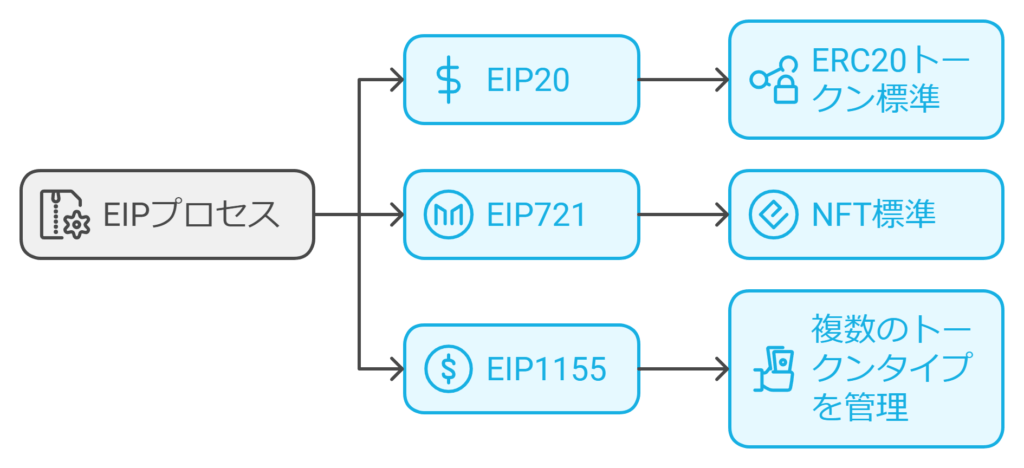
The EIP process enables community-driven decentralized governance and supports the continued evolution of Ethereum.
Conclusion.
Ethereum extends the Bitcoin concept to a more flexible and powerful blockchain platform. Smart contract capabilities allow for the development of a wide range of applications outside of the financial sector.
Scalability challenges remain, but the development team is committed to continuous improvement, and with major updates such as The Merge and Sharding, Ethereum continues to evolve into the next generation blockchain platform.
The development of Ethereum expands the possibilities of decentralized technology and offers new alternatives to traditional centralized systems. The future will continue to see technological advances and the emergence of practical applications.
Supplemental explanation of terminology
- Markle Patricia Tree: A data structure for efficient data validation and management. Combination of Markle Tree and Patricia Tree.
- GHOST Protocol: A consensus algorithm that addresses the blockchain bifurcation problem. The weight of the chain is determined by considering the branched blocks.
- solidity: Ethereum's smart contract description language, with JavaScript-like syntax.
- The Merge: Major update to Ethereum's PoW to PoS transition, implemented in September 2022.
- Sharding: Parallel processing technology for blockchain data. The network is divided into multiple "shards" to increase processing power.
- Layer 2Scalability: Scalability improvement measures by processing transactions outside of the main chain, including technologies such as Optimistic Rollups and Zero-Knowledge Rollups.
The content of this article is based on material from the Blockchain Innovation Endowed Chair offered by the University of Tokyo. Academic efforts such as this are crucial to deepening our understanding of blockchain technology and creating new innovations. We will need to continue to pay close attention to the technological evolution and expanding applications of Ethereum.
Development Information
- Official Website
- Ethereum.org - Official Ethereum website
- Developer Documentation
- Ethereum Developer Resources - Developer Documentation
Blockchain Explorer
- Etherscan
- Etherscan - Ethereum Blockchain Explorer
Community
- Reddit
- r/ethereum - Ethereum Reddit Community
- Twitter
- Ethereum (@ethereum) - Official Ethereum Twitter account
